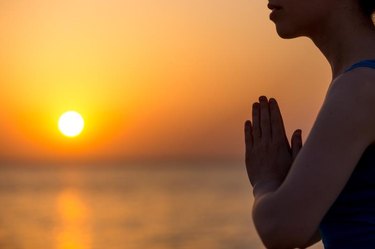
It's been a grueling yet relaxing yoga class, and you might be able to lay in Savasana forever. At the end of your class, though, your instructor will probably bring you to a seated position, press her hands together and murmur something that sounds like Sanskrit to you.
Well, it is Sanskrit — at the end of a typical yoga class, the instructor leads the class in saying and gesturing "Namaste," a symbol of gratitude and respect. Often, she will say it first, and you will repeat it back. Although some teachers might signal Namaste at both the beginning and the end of a class, it's typically done at the end because the room's energy is peaceful and the mind is less active.
Video of the Day
Video of the Day
Read More: What to Wear to Yoga
Meaning of Namaste
In yoga, there's a belief that there is a divine spark in everyone, located in the heart chakra. This chakra — one of seven — affects the ability to love and is located just above your heart in the center of your chest. By gesturing Namaste, you acknowledge that spark and the soul in another person. Literally translated, Nama means "bow," as means "I" and te means "you" — "Bow I you," or "I bow to you."
Some instructors might take this a little bit further, adding a phrase of their choice, such as, "The light in me honors the light in you." She might also add, "The teacher in me bows to the teacher in you." Although she might be officially the instructor, this form of gratitude and respect is a way to symbolize that she appreciates that she can learn from you, the participant, as well.

Read More: Basic Yoga Terminology
How to Perform Namaste
You can perform Namaste while sitting or standing. Bring your hands together, pressing the palms to touch, in front of your heart. Close your eyes and bow your head. Alternatively, you can place your hands together in the middle of your forehead, or your Third Eye, bow your head farther than you would normally and bring your hands down to your heart. The latter typically signifies deep respect. The Third Eye chakra is located between your eyes and governs your ability to focus on and see the bigger picture.
In the Western world, participants typically speak the word "Namaste;" however, in other cultures, such as in India, typically only the gesture is made. It might feel as if you're praying; however, yoga is not a religion, and the hand position is simply a symbol of respect.